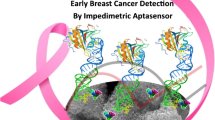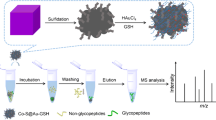Abstract
The development of a novel signal amplification system is described for sensitive determination of α2,6-sialylated glycans (α2,6-sial-Gs), an important prognostic tumor biomarker. First, Fe-based metal-organic frameworks (Fe-MOFs) with silver nanoparticles (AgNPs) decorated onto the outer surface were designed and synthesized with controlled octahedron structures. The new Ag/Fe-MOFs nanocomposite possessed strong conductivity and a large surface area to carry more nanoprobes. To connect the Ag/Fe-MOFs nanocomposite with more groups, the nanocomposite was functionalized by -COOH with SH-PEG-COOH to bind with an α2,6-sial-Gs catcher, M-APBA, via -CONH- bonds. More importantly, the Ag/Fe-MOFs also exhibited an excellent endogenous redox mediator property to produce electrons, which is the fundamental mechanism underlying amplification of an electronic signal. A gold electrode was used to accelerate electron transfer and immobilize the α2,6-sial-Gs lectin (SNA). After the sandwich-type catcher recognition (SNA/α2,6-sial-Gs/M-APBA), the current peak response was provoked in the process of oxidizing AgNPs to Ag+ in the forward anodic potential sweep, while Cl− in a PBS solution was transferred into Ag+ to maintain charge neutrality. Optimized particles were employed for direct fabrication of the sandwich-type affinity biosensor, which was found to show a linear detection range from 1 fg mL−1 to 1 ng mL−1 with a detection limit of 0.09 fg mL−1. Furthermore, the biosensor exhibited excellent specificity and stability, indicating that such a novel nanobiotechnology platform can be used to initiate potential utility for monitoring biomarkers in serum.
Graphical abstract

(A)Schematic presentation of synthesis and surface modification of Ag/Fe-MOFs. The new Ag/Fe-MOFs nanocomposite possessed commendable conductivity and large surface area to carry more nanoprobe; after functionalizing the Ag/MOFs with SH-PEG-COOH, the functionalized endogenous redox mediator (c-Ag/MOFs) realized the possibility that can connect with the biological catcher. (B) Schematic diagram of electrode construction for detecting α2,6-sialylated glycans (α2,6-sial-Gs). By using the c-Ag/Fe-MOFs functional endogenous redox mediator, we successfully implemented the electrochemical detection of α2,6-sial-Gs.





Similar content being viewed by others
References
Li J, He J, Zhang C, Chen J, Mao W, Yu C (2019) Dual-type responsive electrochemical biosensor for the detection of alpha2,6-sialylated glycans based on AuNRs-SA coupled with c-SWCNHs/S-PtNC nanocomposites signal amplification. Biosens Bioelectron 130:166–173
Dall'olio F, Malagolini N, Di Stefano G et al (1989) Increased CMP-NeuAc:Gal beta 1,4GlcNAc-R alpha 2,6 sialyltransferase activity in human colorectal cancer tissues. Int J Cancer 44:434–439
Recchi MA, Hebbar M, Hornez L, Harduin-Lepers A, Peyrat JP, Delannoy P (1998) Multiplex reverse transcription polymerase chain reaction assessment of sialyltransferase expression in human breast cancer. Cancer Res 58:4066–4070
Wang PH, Li YF, Juang CM et al (2001) Altered mRNA expression of sialyltransferase in squamous cell carcinomas of the cervix. Gynecol Onclo 83:121–127
Zhao Y, Li Y, Ma H, Dong W, Zhou H, Song X, Zhang J, Jia L (2014) Modification of sialylation mediates the invasive properties and chemosensitivity of human hepatocellular carcinoma. Mol Cell Proteomics 13:520–536
Harvey DJ (2011) Derivatization of carbohydrates for analysis by chromatography; electrophoresis and mass spectrometry. J Chromatgr B Analyt Technol Biomed Life Sci 879:1196–1225
Patil SA, Bshara W, Morrison C, Chandrasekaran EV, Matta KL, Neelamegham S (2014) Overexpression of alpha2,3sialyl T-antigen in breast cancer determined by miniaturized glycosyltransferase assays and confirmed using tissue microarray immunohistochemical analysis. Glycoconj J 31:509–521
Tothill IE (2009) Biosensors for cancer markers diagnosis. Semin Cell Dev Biol 20:55–62
Yang B, Zhang S, Fang X, Kong J (2019) Double signal amplification strategy for ultrasensitive electrochemical biosensor based on nuclease and quantum dot-DNA nanocomposites in the detection of breast cancer 1 gene mutation. Biosens Bioelectron 142:111544
Liu YL, Zhao XJ, Yang XX, Li YF (2013) A nanosized metal-organic framework of Fe-MIL-88NH(2) as a novel peroxidase mimic used for colorimetric detection of glucose. Analyst 138:4526–4531
Cao J, Li X, Tian H (2019) Metal-organic framework (MOF)-based drug delivery. Curr Med Chem 21:5949–5969
Xie S, Ye J, Yuan Y, Chai Y, Yuan R (2015) A multifunctional hemin@metal-organic framework and its application to construct an electrochemical aptasensor for thrombin detection. Nanoscale 7:18232–18238
Baghayeri M, Ghanei-Motlagh M, Tayebee R, Fayazi M, Narenji F (2020) Application of graphene/zinc-based metal-organic framework nanocomposite for electrochemical sensing of as(III) in water resources. Anal Chim Acta 1099:60–67
Zhang C, He J, Zhang Y, Chen J, Zhao Y, Niu Y, Yu C (2018) Cerium dioxide-doped carboxyl fullerene as novel nanoprobe and catalyst in electrochemical biosensor for amperometric detection of the CYP2C19*2 allele in human serum. Biosens Bioelectron 102:94–100
Qiao X, Xia F, Tian D (2019) Ultrasensitive “signal-on” electrochemical aptasensor for assay of acetamiprid residues based on copper-centered metal-organic frameworks. Anal Chim Acta 1050:51–59
Chen J, Yu C, Zhao Y (2017) A novel non-invasive detection method for the FGFR3 gene mutation in maternal plasma for a fetal achondroplasia diagnosis based on signal amplification by hemin-MOFs/PtNPs. Biosens Bioelectron 91:892–899
Zhao Y, Yang Y, Cui L (2018) Electroactive Au@Ag nanoparticles driven electrochemical sensor for endogenous H(2)S detection. Biosens Bioelectron 117:53–59
Benton EN, Marpu SB, Omary MA (2019) Ratiometric phosphorescent silver sensor: detection and quantification of free silver ions within silver nanoparticles. ACS Appl Mater Interfaces 11:15038–15043
Saleh T, Ahmed E, Yu L, Kwak HH, Kang BJ, Park KM, Choi KY, Kim BM, Kang KS, Woo HM (2019) Characterization of silver nanoparticle-modified decellularized rat esophagus for esophageal tissue engineering: structural properties and biocompatibility. J Biosci Bioeng 128:613–621
Liu R, Yu T, Shi Z, Wang Z (2016) The preparation of metal-organic frameworks and their biomedical application. Int J Nanomedicine 11:1187–1200
Baghayeri M, Veisi H, Ghanei-Motlagh M (2017) Amperometric glucose biosensor based on immobilization of glucose oxidase on a magnetic glassy carbon electrode modified with a novel magnetic nanocomposite. Sensor Actuat B-Chem 249:321–330
Baghayeri M, Veisi H, Farhadi S, Beitollahi H, Maleki B (2018) Ag nanoparticles decorated Fe3O4/chitosan nanocomposite: synthesis, characterization and application toward electrochemical sensing of hydrogen peroxide. J Iran Chem Soc 15:1015–1022
Kong W, Guo X, Jing M et al (2019) Highly sensitive photoelectrochemical detection of bleomycin based on au/WS2 nanorod array as signal matrix and Ag/ZnMOF nanozyme as multifunctional amplifier. Biosens Bioelectron 15(150):111875
Kreno LE, Leong K, Farha OK, Allendorf M, van Duyne RP, Hupp JT (2012) Metal-organic framework materials as chemical sensors. Chem Rev 112:1105–1125
Chen J, Yu C, Zhao Y, Niu Y, Zhang L, Yu Y, Wu J, He J (2017) A novel non-invasive detection method for the FGFR3 gene mutation in maternal plasma for a fetal achondroplasia diagnosis based on signal amplification by hemin-MOFs/PtNPs. Biosens Bioelectron 91:892–899
Wang Y, Zhao G, Zhang Y, Pang X, Cao W, du B, Wei Q (2018) Sandwich-type electrochemical immunosensor for CEA detection based on Ag/MoS2@Fe3O4 and an analogous ELISA method with total internal reflection microscopy. Sensor Actuat B-Chem 266:561–569
Shankar SS, Rai A, Ahmad A, Sastry M (2004) Rapid synthesis of Au, Ag, and bimetallic Au core-Ag shell nanoparticles using neem (Azadirachta indica) leaf broth. J Colloid Interface Sci 275:496–502
Yuan Q, He J, Niu Y, Chen J, Zhao Y, Zhang Y, Yu C (2018) Sandwich-type biosensor for the detection of alpha2,3-sialylated glycans based on fullerene-palladium-platinum alloy and 4-mercaptophenylboronic acid nanoparticle hybrids coupled with Au-methylene blue-MAL signal amplification. Biosens Bioelectron 102:321–327
Arkan E, Saber R, Karimi Z, Shamsipur M (2015) A novel antibody-antigen based impedimetric immunosensor for low level detection of HER2 in serum samples of breast cancer patients via modification of a gold nanoparticles decorated multiwall carbon nanotube-ionic liquid electrode. Anal Chim Acta 874:66–74
Gao L, He J, Xu W, Zhang J, Hui J, Guo Y, Li W, Yu C (2014) Ultrasensitive electrochemical biosensor based on graphite oxide, Prussian blue, and PTC-NH2 for the detection of alpha2,6-sialylated glycans in human serum. Biosens Bioelectron 62:79–83
Li Y, He J, Niu Y, Yu C (2015) Ultrasensitive electrochemical biosensor based on reduced graphene oxide-tetraethylene pentamine-BMIMPF6 hybrids for the detection of alpha2,6-sialylated glycans in human serum. Biosens Bioelectron 74:953–959
Acknowledgments
We are grateful for the financial support from Chongqing precision medical key technology research and development and demonstration projects (cstc2016shms-ztzx0042).
Author information
Authors and Affiliations
Corresponding author
Ethics declarations
Conflict of interest
The authors declare that they have no competing interest.
Additional information
Publisher’s note
Springer Nature remains neutral with regard to jurisdictional claims in published maps and institutional affiliations.
Electronic supplementary material
ESM 1
(DOCX 351 kb)
Rights and permissions
About this article
Cite this article
Zhao, Y., Chen, J., Zhong, H. et al. Functionalized Ag/Fe-MOFs nanocomposite as a novel endogenous redox mediator for determination of α2,6-sialylated glycans in serum. Microchim Acta 187, 649 (2020). https://doi.org/10.1007/s00604-020-04608-w
Received:
Accepted:
Published:
DOI: https://doi.org/10.1007/s00604-020-04608-w




